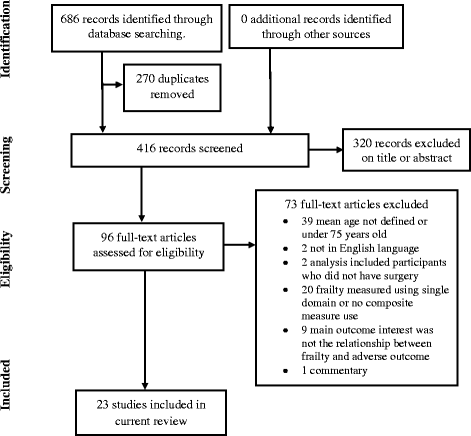Frailty and post-operative outcomes in older surgical patients: a systematic review
- PMID: 27580947
- PMCID: PMC5007853
- DOI: 10.1186/s12877-016-0329-8
Frailty and post-operative outcomes in older surgical patients: a systematic review
Abstract
Background: As the population ages, increasing numbers of older adults are undergoing surgery. Frailty is prevalent in older adults and may be a better predictor of post-operative morbidity and mortality than chronological age. The aim of this review was to examine the impact of frailty on adverse outcomes in the 'older old' and 'oldest old' surgical patients.
Methods: A systematic review was undertaken. Electronic databases from 2010 to 2015 were searched to identify articles which evaluated the relationship between frailty and post-operative outcomes in surgical populations with a mean age of 75 and older. Articles were excluded if they were in non-English languages or if frailty was measured using a single marker only. Demographic data, type of surgery performed, frailty measure and impact of frailty on adverse outcomes were extracted from the selected studies. Quality of the studies and risk of bias was assessed by the Epidemiological Appraisal Instrument.
Results: Twenty-three studies were selected for the review and they were assessed as medium to high quality. The mean age ranged from 75 to 87 years, and included patients undergoing cardiac, oncological, general, vascular and hip fracture surgeries. There were 21 different instruments used to measure frailty. Regardless of how frailty was measured, the strongest evidence in terms of numbers of studies, consistency of results and study quality was for associations between frailty and increased mortality at 30 days, 90 days and one year follow-up, post-operative complications and length of stay. A small number of studies reported on discharge to institutional care, functional decline and lower quality of life after surgery, and also found a significant association with frailty.
Conclusion: There was strong evidence that frailty in older-old and oldest-old surgical patients predicts post-operative mortality, complications, and prolonged length of stay. Frailty assessment may be a valuable tool in peri-operative assessment. It is possible that different frailty tools are best suited for different acuity and type of surgical patients. The association between frailty and return to pre-morbid function, discharge destination, and quality of life after surgery warrants further research.
Keywords: Frailty; Geriatric; Mortality; Oldest old; Post-operative complications.
Figures
Comment in
-
Re: Frailty and Post-Operative Outcomes in Older Surgical Patients: A Systematic Review.J Urol. 2017 Aug;198(2):229-230. doi: 10.1016/j.juro.2017.05.052. Epub 2017 May 15. J Urol. 2017. PMID: 29370601 No abstract available.
References
-
- Health & Social Care Information Centre. Hospital Episode Statistics, Admitted Patient Care - England, 2014–15: Procedures and interventions. http://digital.nhs.uk/searchcatalogue?productid=19420&q=Hospital+Episode.... Accessed 23 Aug 2016.
-
- Health & Social Care Information Centre. Hospital Episode Statistics, Admitted Patient Care - England, 2006–07: Main operations summaries. http://digital.nhs.uk/searchcatalogue?productid=92&q=Hospital+Episode+St.... Accessed 23 Aug 2016.
-
- Australian Institute of Health and Welfare. Australian hospital statistics 2012–13. In: Health services series; no 54. Canberra: Australian Institute of Health and Welfare; 2014.
-
- Rockwood K, Howlett SE, MacKnight C, Beattie BL, Bergman H, Hebert R, et al. Prevalence, attributes, and outcomes of fitness and frailty in community-dwelling older adults: report from the Canadian study of health and aging. J Gerontol A Biol Sci Med Sci. 2004;59(12):1310–1317. doi: 10.1093/gerona/59.12.1310. - DOI - PubMed
Publication types
MeSH terms
LinkOut - more resources
Full Text Sources
Other Literature Sources
Medical
Research Materials


